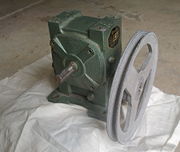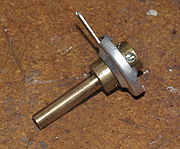
Reduction drive
Encyclopedia

Ball bearing
A ball bearing is a type of rolling-element bearing that uses balls to maintain the separation between the bearing races.The purpose of a ball bearing is to reduce rotational friction and support radial and axial loads. It achieves this by using at least two races to contain the balls and transmit...
s in an epicyclic
Epicyclic gearing
Epicyclic gearing or planetary gearing is a gear system consisting of one or more outer gears, or planet gears, revolving about a central, or sun gear. Typically, the planet gears are mounted on a movable arm or carrier which itself may rotate relative to the sun gear...
arrangement instead of toothed gear
Gear
A gear is a rotating machine part having cut teeth, or cogs, which mesh with another toothed part in order to transmit torque. Two or more gears working in tandem are called a transmission and can produce a mechanical advantage through a gear ratio and thus may be considered a simple machine....
s.

Engine
An engine or motor is a machine designed to convert energy into useful mechanical motion. Heat engines, including internal combustion engines and external combustion engines burn a fuel to create heat which is then used to create motion...
s of all kinds, to increase the amount of torque
Torque
Torque, moment or moment of force , is the tendency of a force to rotate an object about an axis, fulcrum, or pivot. Just as a force is a push or a pull, a torque can be thought of as a twist....
per revolution of a shaft: the gearbox of any car
Automobile
An automobile, autocar, motor car or car is a wheeled motor vehicle used for transporting passengers, which also carries its own engine or motor...
is a ubiquitous example of a reduction drive. Common household uses are washing machines, food blenders and window-winders.
Planetary reduction drives are typically attached between the shaft of the variable capacitor
Variable capacitor
A variable capacitor is a capacitor whose capacitance may be intentionally and repeatedly changed mechanically or electronically. Variable capacitors are often used in L/C circuits to set the resonance frequency, e.g. to tune a radio , or as a variable reactance, e.g...
and the tuning knob of any radio
Radio
Radio is the transmission of signals through free space by modulation of electromagnetic waves with frequencies below those of visible light. Electromagnetic radiation travels by means of oscillating electromagnetic fields that pass through the air and the vacuum of space...
, to allow fine adjustments of the tuning capacitor with smooth movements of the knob. Planetary drives are used in this situation to avoid "backlash", which makes tuning easier. If the capacitor drive has backlash, when you attempt to tune-in a station, the tuning knob will feel sloppy and it will be hard to perform small adjustments. Gear-drives CAN be made to have no backlash by utilising split gears and spring tension but the shaft bearings have to be very precise.

